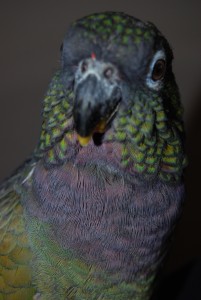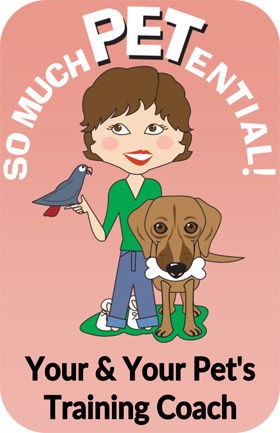applied behavior analysis
Preventing Dog Behavior Problems At Thanksgiving
NOTE: I have a new pet behavior blog located at http://www.SoMuchPETential.com/blog. Thanks!
Thanksgiving is quickly coming upon us. Oh to taste the turkey…stuffing…sweet potatoes…and pumpkin pie. I can hardly wait! So can Sam….and I bet your favorite pooch too.
So, let’s plan ahead. Sharing your meal with your guests AND your dog doesn’t necessarily have to be part of the holiday. The time to work on  teaching your dog new skills is now – not dinner time on November 22.
teaching your dog new skills is now – not dinner time on November 22.
Let’s put our applied behavior analysis thinking caps on and brainstorm. Remember, ABA is a systematic approach to solving behavior problems by changing the environment in which the behavior occurs.
We ask ourselves “What happened IMMEDIATELY prior to the behavior (antecedent) to set the ball rolling for the behavior?” and “What happened IMMEDIATELY after the behavior to reinforce it (consequence)?”
I’m going to simplify it and use for the sake of this column that the antecedent is ‘guests sitting at the dinner table with unbelievably savory food on dishes in front of them.’ The behavior is your dog bumping or scratching guests in their seats. (We’ll call this ‘begging.’) The consequence is that eventually your dog may get either attention or turkey or jackpot – BOTH!
How can we change the environment to set your dog up for success? If you know in advance that this is highly predictable behavior, you can use antecedent strategies to give less value to the begging. Some ideas? Satiate your dog BEFORE you sit down by feeding him in advance, redirect his attention by giving him a tasty steak bone to chew on or a foraging toy that will keep his attention for awhile, take him for a long walk or run prior to the meal to increase the value of resting behavior.
Another idea would be to teach your dog – in advance – an alternative behavior that will reap him the same or more reinforcing value than what he would get if he begged while also removing all positive consequences of begging. Remember, as his teacher, his ability to learn is dependent on your reliability (and EVERYONE in your household) to quickly reinforce the behavior you want to see – and every time he does the behavior in the beginning.
So, begin by teaching the alternative behavior (like sitting or laying down) and get it reliably on cue. Once on cue start teaching him to hold that behavior for longer durations before delivering reinforcement. Then, you can cue him to do the behavior before you sit down to a meal and reinforce it. At the same time, if he begs, you can simply push your plate in to the center of the table and turn your back to him while sitting. Practice. Practice Practice.
Dogs are pretty smart. If ‘you’ teach him that begging only gets people to turn away and push food aside but sitting or laying down gets a nifty treat, guess which choice he’ll make?
If you have a dog who is competing with our Sam for the title, World Champion Counter-Surfer, remember, often times the feat is carried out when your back is turned. (We know this from experience.) The simplest solution is eliminating access to the reinforcement that maintains the behavior. In other words, always be cognizant of being sure that tasty food is kept far enough from the counter edge that your dog can not reach it.
Stopping Parrot Biting Without Force
NOTE: I have a new pet behavior blog. Please visit http://www.SoMuchPETential.com/blog. Thanks!
Dreyfuss is a bird who – if I’d let her – would spend her entire day sitting next to me or on me, frequently with her head down for rubs. So how was it that this sweet girl (who actually may be a boy but I’ve never had her sexed) would lung at my bare arm, and even bite it, when I’d put my arm in front of her body before asking for a ‘step up’ from her inside cage perch?
My education in behavior has taught me that biting doesn’t just ‘occur’ in a vacuum, and that before that aggressive behavior happens, a bird behaves with nonaggressive body language (such as dilated eyes, feathers fluffed) to let me know my arm is not wanted in its space. If I get bitten it is because I did not pull my arm away when the bird dilated its eyes or fluffed its feathers, causing the bird to need to escalate its behavior.
Yes, I know that. But I had been watching Dreyfuss’ body language and I just couldn’t see it. One second her body language was telling me she was eager to step up and the next split second she’d lunge.
My turning point came the moment I had written an email to a trainer I know. In it, I told her Dreyfuss’ behavior was ‘unpredictable’. I hit send and then had a WOAH moment. Hold on here, Lisa. You know better than that. And you have the skills to solve this without the use of force and set both you and Dreyfuss up for success.
Applied behavior analysis is a systematic approach to solving behavior problems by changing the environment in which the behavior occurs. It involves looking at the very specific behavior (such as a bird biting or screaming) and the related environmental context that signals and reinforces it. We ask, “What happened *immediately* prior to the behavior (antecedent) to set the whole ball rolling?“ And, “What happened *immediately* after the behavior to reinforce it (consequence)?“
There you have it…the A (antecedent), B (behavior), and C (consequence)’s.
So, let’s look at the ABC’s of this situation.
A(antecedent): Lisa puts hand on cage door
B (behavior): Dreyfuss either rocks from foot to foot or with slight movement
C (consequence): Lisa opens cage door
A: Lisa moves arm to Dreyfuss saying ‘step up’
B: Dreyfuss lunges or bites
C: Lisa removes hand
Prediction: Dreyfuss will lunge or bite more to get Lisa to remove her hand
I know, this doesn’t make sense for a bird that, once is on me, could live there. But obviously there is something about my arm being put in front of her that she didn’t want to have happen. How do I know? Because her behavior of biting/lunging continued and got more frequent.
The thing about studying behavior is that I don’t need to know what Dreyfuss was thinking. I only need to know that the behavior had a function for 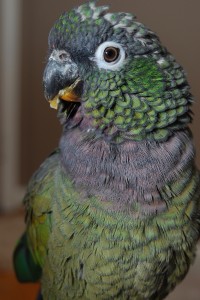 her in her environment and I can then modify the environment to modify the behavior. I like to think about it as teaching new skills.
her in her environment and I can then modify the environment to modify the behavior. I like to think about it as teaching new skills.
So, what did I do? Well, I DID NOT use punishment or any kind of force.
What I did do is create a plan that would set us both up for success.
I taught her the contingency that *when* I put my hand on her door, *if* she moves to the left side of the perch, *then* I will put my arm in front of the right side of the perch. And *if* she walks over to and steps up onto my arm, *then* she comes out for attention, seeds, and more.
The power of deciding whether to come toward my arm to come out – or not – was ALL up to HER. And guess what, given the choice, she not only decided to come to my arm every single time – she runs to it and jumps on board.
How great is that!
So, here is the new ABC:
A: Lisa puts hand on door
B: Dreyfuss moves to other side of perch
C: Lisa puts hand at opposite side of perch
2nd ABC:
A: Lisa puts hand at opposite side of perch
B: Dreyfuss moves to hand and steps up
C: Lisa takes Dreyfuss out for attention, seed and more
Taking her out of her cage is that simple now. The beauty of it is that I never used force or punishment. My ‘unpredictable’ bird when it comes to getting her out of her cage, now reliably runs with her feathers relaxed to my arm and as a result we both have confidence in that situation.
To read my post on why parrots bite, please click this link.
Solving Pet Parrot Phobic Behavior – Positively
NOTE: I have a new pet behavior blog located at http://www.SoMuchPETential.com/blog. Thanks!
Note: This is a past column from my Hyde Park Living pet behavior column.
Every once in awhile you have the opportunity to read about my personal stories as they pertain to modifying pet behaviors in the most positive, least intrusive ways. I’ve been studying this for nearly four years now. Not only has it completely changed my relationship with my three parrots, I find it absolutely fascinating.
This month, I will focus on fear. With birds especially, I’ve often heard people talk of their pet’s sudden neurotic, phobic behaviors. Out of the blue, for no apparent reason, their loving companion will scream, lunge or try to escape 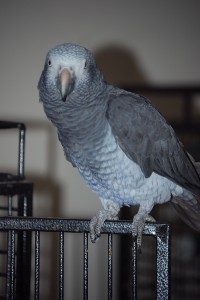 the hands that up until that moment had only been associated with positive things.
the hands that up until that moment had only been associated with positive things.
I know about this, unfortunately, from firsthand knowledge. My loving Barnaby Timneh African Grey, who normally would be very happy spending his entire day with his face pressed against mine (of course it would have to be with the occasional play break), would suddenly ‘out of the blue’ panic when he stepped onto my arm. He’d scream with horror in his voice, breathe heavily, and then take off. If you’ve ever experienced the unconditional love of an animal, you can probably understand it is completely heartbreaking when you are thrust into the portrayal of some evil monster – and you don’t even know why.
Each time it would happen with Barnaby, I’d have to go through a systematic desensitization plan to help him overcome his anxiety. Because we have a long history of trust, we were able to work through this fairly quickly, but my training taught me there had to be a reason for this reoccurring behavior. And there also had to be a way of eliminating or minimizing the frequency of it. Behavior, I know, doesn’t ever happen willy nilly. It is always triggered by something in the environment. And the consequences of that behavior are what either maintains, builds or extinguishes it.
Hmm. Actually it became fairly easy to figure out once I put on my behavior analysis hat.
There is a window in the birds’ room that faces the street. On sunny days, when a car drives past, the light that reflects from the metal and glass makes a brilliant pass from one wall to the next. A pretty scary demon to a Timneh teddy bear no longer than a ruler. If my neighbor parks her car in a certain spot at a certain time of day and Barnaby happens to be way up high, that same evil light hovers. Each time that Barnaby jumped on my arm, only to be terrified, that same ‘trigger’ light just happened to be coming from the street.
My mentor and teacher, Dr. Susan Friedman – a respected psychologist and behaviorist – helped me to understand. Purely based on my poor timing, in Barnaby’s mind, I got associated with the light. And that was not a good thing to be paired with.
Barnaby had two types of behaviors going on. One was an automatic, involuntary response to a bright light (panic scream, escape). In scientific terminology, this is called an unconditioned or respondent behavior because it wasn’t something that Barnaby learned in the way that he came to know stepping up generally meant only good things would follow. On the other hand, his stepping up behavior is most definitely learned. Scientists call that operant learning.
Now, think of the use of a clicker. The clicker in and of itself is meaningless to an animal. It only acquires value to that animal when a good trainer repeatedly pairs the sound with a treat. Then the click acquires reinforcing value.
This same type of association was going on with Barnaby, only it was a negative one. Being on my arm – something that had always given him positive reinforcement in the past – when the light (remember, something that causes an unconditioned fear response) came through the window, was being paired with that fear response. Just as the words ‘good boy’ have become associated with safflower seeds, his being on my arm had become associated with that awful light.
Once this became clear, working toward a solution really wasn’t that difficult. What I learned from Susan (and so many great people on Susan’s international parrot behavior listserve) is how to modify Barnaby’s environment so as to set him up for success. When I’m working from home, I try to remember to close their shade at a certain time. But if the shade is up, and there is that dangerous light outside (at least in his eyes), I absolutely will not pick him up. Instead, he’s learned to go inside his cage at that time. That one small adjustment has meant the difference between a pet who became instantly phobic of me – on a more frequent basis – to one who hasn’t exhibited those behaviors once since I figured it all out. So, it really wasn’t just some irrational fear after all.
This isn’t to say that something else in the future may pop up, that will cause that same fear response. Barnaby is a living being, and, as life goes, behaviors evolve all the time to adapt to the environment. But next time, I’m going to be better equipped to send those awful monsters packing so Barnaby can just focus on having fun.
ABC’s of Pet Behavior, Part Two
Note: Please visit my pet behavior blog at http://www.SoMuchPETential.com/blog.
(from my Hyde Park Living column)
Last month I explained the ABCs of behavior and we can use them as the most positive, least intrusive way of managing and modifying our pet’s behavior. This month I thought I’d show you a little how it works.
First, let me recap. Applied behavior analysis is a systematic approach to solving behavior problems by changing the environment in which the behavior occurs. It involves looking at the very specific behavior (such as a bird biting or screaming) and the related environmental context that signals and reinforces it. We ask, “What happened *immediately* prior to the behavior (antecedent) to set the whole ball rolling?“ And, “What happened *immediately* after the behavior to reinforce it (consequence)?“
I’m going to use the example of our family dog, Sam, who has an earned reputation for pawing my mom when we eat or standing with his two front paws on the table looking for a prize. For the purpose of this column, I will label that set of 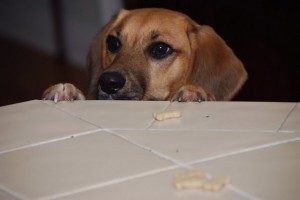 observable behaviors as ‘bad table manners.’
observable behaviors as ‘bad table manners.’
The setting event for ‘bad table manners’ is our sitting around the table with food. The consequence may be any number of things…my mom trying to ignore him but sometimes hugging him, sometimes telling him he’s bad, sometimes giving him a treat. You get the picture?
Since I know under what conditions his behavior is highly predictable, I can decrease the value of that behavior with antecedent strategies. I can play rough with him just prior to our sitting down to get him tired and less motivated to have ‘bad table manners.’ I can (and always do) make him a foraging toy that he only gets before we eat and that keeps him busy for awhile. (I break up pieces of treats, and intertwine them in knotted plastic grocery bags that are then stuffed into a heavy rubber ball.)
Another thing I have done was teach him an alternative behavior (actually he knows a lot of behaviors) that, when we are sitting at the table, he knows in black & white terms that *if * he does that behavior next to me – which I chose as sitting or laying down – *then* he will get reinforced with attention and small pieces of food. (Okay, I admit I feed him some at the table but only when he is doing a behavior I taught him is acceptable.) At the same time, I have removed all positive consequences of his bad table manners (which meant when he jumps or paws, I simply turn my back and push my plate to the center of the table).
Guess which behavior he does more of now? Heck, if I were him and I REALLY wanted a taste off that plate, and knew the only sure fire way of getting a sample was to sit or lay down, I think I’d choose to sit or lay down too. And I’d do it pretty darned fast.
What is so wonderful about this is that punishment never had to be used, only empowerment. Sam has learned to succeed because I am clear cut in teaching him what I want him *to* do and because I make learning fun. Let me say that again. At every step along the way…learning is fun.
To read part one, please click here.
Do You Know The ABC’s Of Pet Behavior?
NOTE: I have a new pet behavior blog located at http://www.SoMuchPETential.com/blog. Thanks!
(past Hyde Park Living column)
Do you know your ABC’s?
Well that’s a strange question you may be saying to yourself. Isn’t this a pet behavior column?
Yep, it sure is. And the ABC’s I’m talking about are not related to spelling words. They are instead what I have been taught to help me understand why a behavior occurs so that as a pet owner and teacher, I can effectively set my animals up for success by influencing their behavior in the most positive/least intrusive way.
Let me back up. What I really would like for you to get from this column is a basic understanding that blaming an animal for doing anything you don’t want him to do is simply counterproductive. All behavior happens because it is serving a purpose for that animal. We may never know at any given time what our animal is feeling or thinking when he jumps on us or chews up a garden hose but we don’t need to know to still set our animal up to succeed. Using the ABC assessment, we can modify the animal’s environment and modify his behavior without any use of force or punishment.
The science of behavior
Applied behavior analysis is a systematic approach to solving behavior problems by changing the environment in which the behavior occurs. It involves looking at the very specific behavior (such as a bird biting or screaming) and the related environmental context that signals and reinforces it. We ask, “What happened *immediately* prior to the behavior (antecedent) to set the whole ball rolling?“ And, “What happened *immediately* after the behavior to reinforce it (consequence)?“
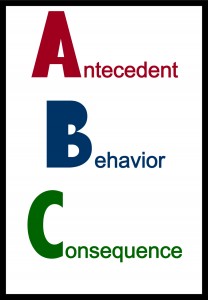 There you have it…the A (antecedent), B (behavior), and C (consequence)’s.
There you have it…the A (antecedent), B (behavior), and C (consequence)’s.
All too often when our pet is doing something we disapprove of we don’t even realize that we are responsible for reinforcing the very action we don’t want to see. Or in the heat of the moment, we end up punishing our pet – which can have detrimental side effects (the subject for a future column) and serves no teaching function.
Using the ABC assessment tool allows us to consider how we can rearrange the antecedents so that the problem behavior is never set into motion to begin with – and we can set into motion an acceptable behavior instead. Then we can reinforce the heck out of the acceptable behavior. Guess which behavior you’ll see more of?
In my next column I’ll work through a specific example of using the ABC analysis in solving a pet behavior issue.

